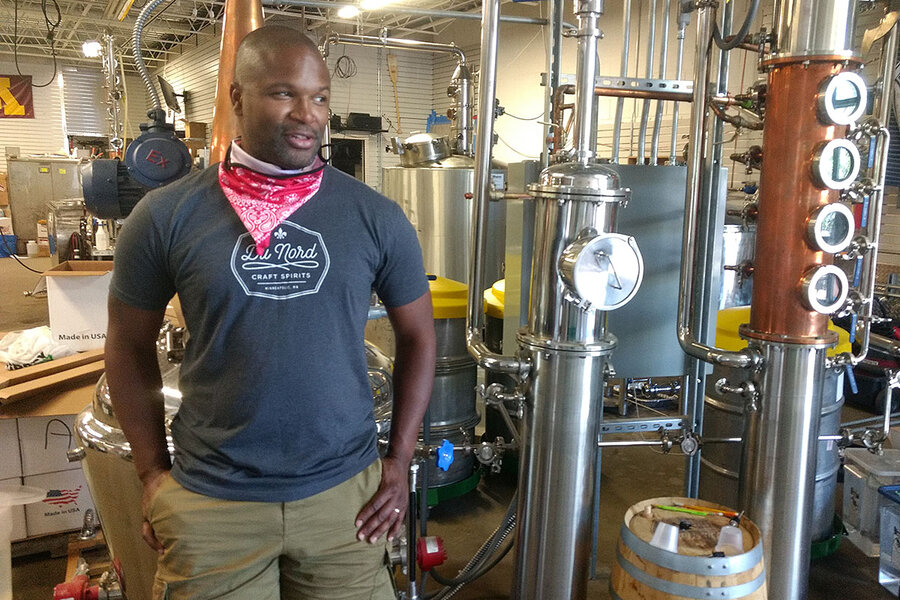‘Justice needs to be served’: Minneapolis businesses put principles first
Loading...
| Minneapolis
A desire for racial justice and a distinct lack of self-pity unite small business owners in Minneapolis’ Longfellow neighborhood as they attempt to recover from the fires, looting, and vandalism that damaged or destroyed almost 1,500 businesses in the Twin Cities.
The neighborhood of 5,000 residents – a mix of young families, downtown workers, and retirees – absorbed perhaps the heaviest blow of any in Minneapolis and St. Paul. The casualty list includes grocery, drug and department stores, dozens of restaurants and cafes, the post office, a medical clinic, and a 200-unit affordable housing complex that was under construction.
Why We Wrote This
Minneapolis’ small businesses were already having a precarious 2020 because of the pandemic. Then 1,500 were burned or looted during outrage over George Floyd’s killing. Instead of anger or self-pity, many say their life’s work can’t compare to a lost life.
Residents have rushed to ease the hardship of businesses by cleaning up debris and contributing to recovery funds and GoFundMe campaigns for rebuilding efforts. Yet for Longfellow business owners, many of them people of color, the outpouring neither obscures nor alleviates an uncertain future as the coronavirus clogs the economy and the city struggles with enduring racial inequities.
“Most people who run small businesses don’t see it as only a job,” says Jamie Schwesnedl, co-owner of Moon Palace Books. “They’re part of the neighborhood, and their customers are their neighbors. The way we see it, we’re in this together.”
First came the pandemic. In March, as Minnesota and the country ran low on certain essential supplies, Chris and Shanelle Montana realized they could help meet demand for one coveted item and, in turn, save their business. The owners of Du Nord Craft Spirits, a microdistillery that opened in 2013, they started producing a new alcohol-based commodity, switching from vodka, gin, and whiskey to hand sanitizer.
Then came the protests. After Minneapolis police killed George Floyd on Memorial Day, demonstrations erupted in the state’s largest city. The four officers charged in Mr. Floyd’s death worked out of the 3rd Precinct in the Longfellow neighborhood, five blocks from Du Nord. Mr. Montana braved clouds of tear gas to hand out bottled water and hand sanitizer to protesters as they filled the streets around the police station.
And then came the destruction. As mostly peaceful marches in the area gave way to sporadic rioting, looters started a fire in Du Nord’s warehouse, setting off the sprinkler system. Water flooded the building and caused its ceiling to collapse. Shaking off their initial distress, the Montanas rallied employees and volunteers to convert the warehouse into a food bank, where residents in need could pick up donated goods.
Why We Wrote This
Minneapolis’ small businesses were already having a precarious 2020 because of the pandemic. Then 1,500 were burned or looted during outrage over George Floyd’s killing. Instead of anger or self-pity, many say their life’s work can’t compare to a lost life.
The couple decided against defending their business as protests flared. “There’s nothing in here that’s worth a life,” Mr. Montana says, standing in Du Nord’s almost unscathed main building, a space that contains its distillery equipment and cocktail room. He attributes its survival to his employees, who boarded up windows with signs that read “Black-Owned.”
“Our thinking was, ‘We’re going to give the building to Minneapolis and continue to support the demonstrations,’” says Mr. Montana, one of the country’s few Black distillery owners. “As much as this place means to us, you can’t compare that with what happened to George Floyd.”
A desire for racial justice and a distinct lack of self-pity unite small business owners in Longfellow as they attempt to recover from the fires, looting, and vandalism that damaged or destroyed almost 1,500 businesses in Minneapolis and St. Paul.
The neighborhood of 5,000 residents – a mix of young families, downtown workers, and retirees – absorbed perhaps the heaviest blow of any in the Twin Cities. The casualty list includes grocery, drug, and department stores, dozens of restaurants and cafes, the post office, a medical clinic, and a 200-unit affordable housing complex that was under construction.
Residents have rushed to ease the hardship of businesses by cleaning up debris and contributing to recovery funds and GoFundMe campaigns for rebuilding efforts. Yet for the Montanas and other Longfellow business owners, many of them people of color, the outpouring neither obscures nor alleviates an uncertain future as the coronavirus clogs the economy and the city struggles with enduring racial inequities.
“The pandemic and the protests have been a double gut punch,” says Karl Benson, president of the Minnesota Black Chamber of Commerce. “Most of our minority businesses owners won’t be able to last without government grants and subsidies because they don’t have much in the way of financial reserves to ride things out. There are a lot of tough days ahead.”
“Let my building burn”
The riots blunted in a matter of days the gradual progress that Longfellow has nurtured over the past quarter-century. Minority-owned businesses lie at the heart of the revival in a neighborhood located a 10-minute drive from downtown and known for its tree-lined streets, ethnic restaurants, and lower cost of living relative to most of Minneapolis.
The area began to grow in size and diversity in the mid-1990s after stagnating for two decades as white residents departed for the suburbs. A steady flow of immigrants from Africa, Latin America, and South Asia settled in Longfellow and nearby neighborhoods to raise families and pursue career dreams.
Ruhel Islam moved to Minneapolis in 2000, four years after arriving in New York from Bangladesh, and in 2008 he opened a restaurant in Longfellow. Gandhi Mahal weathered the Great Recession and blossomed into a beloved neighborhood spot that attracted customers from across the city and coverage from the Food Network show “Diners, Drive-Ins, and Dives.”
Mr. Islam provided a room in his restaurant for medics to treat injured protesters during the first two nights of unrest after Mr. Floyd’s death. The following night, when rioters set fire to the 3rd Precinct a block away, flames destroyed much of the restaurant.
The next morning, in a Facebook post that went viral, Mr. Islam’s teenage daughter, Hafsa, quoted him as saying, “Let my building burn, justice needs to be served, put those officers in jail.” He likens the largely white police force in Minneapolis – accused for decades of using excessive force against people of color – to the military dictatorship he lived under in his youth in Bangladesh.
“I grew up in a police state,” he says, recalling the deaths of two fellow students at the hands of officers in his homeland. “So I understand why people here are angry.”
Lillie Nelson, a retired assembly-line worker who grew up under Jim Crow laws in the Deep South, has rented her one-bedroom apartment in Longfellow since 2000. The fires during the protests claimed the Aldi, Cub Foods, and Target where she bought groceries and the Walgreens where she picked up her medications.
The loss of the stores has complicated her daily life. Still, Ms. Nelson, who is Black, finds little fault with demonstrators. “I don’t blame them,” she says. “I blame the police. They’ve been treating us wrong as long as I’ve been here.”
Mr. Islam returned to the ruins of Gandhi Mahal on a recent afternoon to salvage items from the ashes and meet with an insurance adjuster. He credits the loyalty of Longfellow residents for his restaurant’s success, and his vow to rebuild extends beyond its charred walls to the community that has embraced him.
“We need to have a multicultural movement for racial justice,” he says. “If all of us do our part, we can fix things so that our children don’t have to deal with the same problems.”
The question remains whether people of color who live in Longfellow will care to wait for buildings to rise and inequality to fall.
Jordan and Emily Baynard, who rent a duplex near Gandhi Mahal, once a favorite dinner destination, lean toward leaving after eight years in Minneapolis. The interracial couple – he’s Black, she’s white – is mulling a move to Charlotte, North Carolina, to raise their two young children in a more racially mixed city.
“We’re tired,” says Mr. Baynard, a national sales manager with a St. Paul company. “We’re asking ourselves, do we want to stay and fight and see if things change? Or do we want to find a more diverse area to live?”
Shared values
The liberal reputation of Minneapolis shrouds chronic disparities in income, education, and housing between minorities and white residents, who make up 60% of the population. A similar imbalance afflicts the business sector, including access to bank loans, and Mr. Benson worries that the damage to businesses in the Twin Cities – with losses estimated at $500 million – will summon the forces of gentrification.
“The hard truth is that there’s now an opportunity for white developers to buy properties for pennies on the dollar,” he says. The added burden of rebuilding during a pandemic could persuade minority business owners in Longfellow and other neighborhoods to walk away. “There’s a realization that this is a chance to take the insurance money and get out.”
Mr. Montana says he felt the urge to close his distillery for good when knee-high water gushed out of his flooded warehouse in late May. He has heard from several business owners in the area who have received offers to sell.
“We know the developers are out there circling,” says Mr. Montana, a former attorney and the father of three children. He and his wife hope to resume producing spirits by fall. “We need public officials and the private sector working together to protect our businesses. When we give Black and brown people a path toward business development, that’s how we can build generational wealth and reduce inequality.”
The federal government last week denied Minnesota Gov. Tim Walz’s request for $16 million to assist with rebuilding businesses in the Twin Cities. State lawmakers have proposed a $300 million aid package that would help business owners recover and create a redevelopment agency to preserve small businesses owned by people of color.
The Longfellow Community Council has launched a neighborhood initiative to provide guidance to business owners planning to rebuild. Marya McIntosh, a member of the council’s board of directors, explains that the nonprofit advocacy group seeks to prevent a washing away of the neighborhood’s independent restaurants, coffee shops, and retailers.
“We have to be really vigilant with the city and state to make sure that businesses have enough time to recover,” she says. Ms. McIntosh bought a house in Longfellow five years ago, lured by its affordability, easy access to bus lines, and proximity to downtown, where she works for the Nature Conservancy. “Residents here want to go to businesses that reflect their values. That’s part of what makes a neighborhood feel like a neighborhood.”
The demonstrations revealed those shared values as business owners supported the cause of protesters. Moon Palace Books occupies a storefront less than a block from the 3rd Precinct, and as crowds in the area swelled, police tried to commandeer the shop’s parking lot to use as a staging area. Jamie Schwesnedl, who owns the store with his wife, insisted the cops leave.
Mr. Schwesnedl and his employees posted a large sign in the shop’s upper windows that read “Abolish The Police.” They later boarded up the facade and painted the same message across the wood planks. The building went nearly untouched during the unrest.
“Most people who run small businesses don’t see it as only a job,” he says. “They’re part of the neighborhood, and their customers are their neighbors. The way we see it, we’re in this together.”










